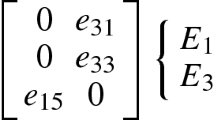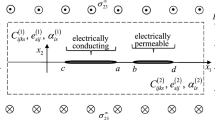Abstract
A plane-strain problem for a limited permeable crack in an adhesive thin interlayer between two semi-infinite piezoelectric spaces is considered. The tensile mechanical stress and the electric displacement are applied at infinity. The interlayer is assumed to be softer than the connected materials; therefore, the zones of mechanical yielding and electric saturations can arise at the crack tips on the continuations of the crack. These zones are considered in this work. It was assumed that the length of electric saturation zones is larger than the length of mechanical yield zones. The zones of mechanical yielding are modeled by the crack continuations with normal compressive stresses applied at its faces. The electric saturation zones are modeled by segments at the crack continuations with prescribed saturated electric displacements. These electric displacements can linearly vary along the mechanical yielding zones. The problem is reduced to the Hilbert–Riemann problem of linear relationship, which is solved exactly. The equation for the determination of the yielding zones length, the expressions for the crack-opening displacement jump, electric potential jump, and J-integral is obtained in an analytical form. In case of finite size body, the finite elements method is used and the variation in the fracture mechanical parameters with respect to this size is demonstrated.
Similar content being viewed by others
References
Wang B.L., Mai Y.W.: On the electrical boundary conditions on the crack surfaces in piezoelectric ceramics. Int. J. Eng. Sci. 41, 633–652 (2003)
Deeg, W.F.: The analysis of dislocation, crack and inclusion problems in piezoelectric solids. Ph.D. Thesis, Stanford University (1980)
Pak Y.E.: Linear electro-elastic fracture mechanics of piezoelectric materials. Int. J. Fract. 54, 79–100 (1992)
Suo Z., Kuo C.M., Barnett D.M., Willis J.R.: Fracture mechanics for piezoelectric ceramics. J. Mech. Phys. Solids 40, 739–765 (1992)
Parton V.Z.: Fracture mechanics of piezoelectric materials. Acta Astronaut. 3, 671–683 (1976)
Parton V.Z., Kudryavtsev B.A.: Electromagnetoelasticity. Gordon and Breach Science Publishers, New York (1988)
Hao T.H., Shen Z.Y.: A new electric boundary condition of electric fracture mechanics and its applications. Eng. Fract. Mech. 47, 793–802 (1994)
Zhao M.H., Fan C.Y.: Strip electric–magnetic breakdown model in a magnetoelectroelastic medium. J. Mech. Phys. Solids 56, 3441–3458 (2008)
Leonov M.Y., Panasyuk V.V.: Development of the smallest cracks in a rigid body. Appl. Mech. 5(4), 391–401 (1959) (in Russian)
Dugdale D.S.: Yielding of steel sheets containing slits. J. Mech. Phys. Solids 8, 100–108 (1960)
Gao H., Barnett D.M.: An invariance property of local energy release rate in a strip saturation model of piezoelectric fracture. Int. J. Fract. 79, R25–R29 (1996)
Shen S., Nishioka T., Kuang Z.B., Liu Z.: Nonlinear electromechanical interfacial fracture for piezoelectric materials. Mech. Mater. 32, 57–64 (2000)
Li S.: On saturation-strip model of a permeable crack in a piezoelectric ceramic. Acta Mech. 165, 47–71 (2003)
Wang B.L., Zhang X.H.: Fracture prediction for piezoelectric ceramics based on the electric field saturation concept. Mech. Res. Commun. 32, 411–419 (2005)
Beom H.G., Kim Y.H., Cho C., Kim C.B.: Asymptotic analysis of an impermeable crack in an electrostrictive material subjected to electric loading. Int. J. Solids Struct. 43, 6869–6886 (2006)
Fan C.Y., Zhao Y.F., Zhao M.H., Pan E.: Analytical solution of a semi-permeable crack in a 2D piezoelectric medium based on the PS model. Mech. Res. Commun. 40, 34–40 (2012)
Zhang T.Y., Gao C.F.: Fracture behavior of piezoelectric materials. Thero. Appl. Fract. Mech. 41, 339–379 (2004)
Gao C.F., Noda N., Zhang T.Y.: Dielectric breakdown model for a conductive crack and electrode in piezoelectric materials. Int. J. Eng. Sci. 44, 256–272 (2006)
Fan C.Y., Zhao M.H., Zhou Y.H.: Numerical solution of polarization saturation/dielectric breakdown model in 2D finite piezoelectric media. J. Mech. Phys. Solids 57, 1527–1544 (2009)
Loboda V., Lapusta Y., Sheveleva A.: Electro-mechanical pre-fracture zones for an electrically permeable interface crack in a piezoelectric biomaterial. Int. J. Solids Struct. 44, 5538–5553 (2007)
Loboda V., Lapusta Y., Govorukha V.: Mechanical and electrical yielding for an electrically insulated crack in an interlayer between piezoelectric materials. Int. J. Eng. Sci. 46, 260–272 (2008)
Lapusta Y., Loboda V.: Electro-mechanical yielding for a limited permeable crack in an interlayer between piezoelectric materials. Mech. Res. Commun. 36, 183–192 (2009)
Loboda V., Lapusta Y., Sheveleva A.: Limited permeable crack in an interlayer between piezoelectric materials with different zones of electrical saturation and mechanical yielding. Int. J. Solids Struct. 47, 1795–1806 (2010)
Bhargava R.R., Jangid K.: Strip electro-mechanical yielding model for piezoelectric plate cut along two equal collinear cracks. Appl. Math. Model. 37, 9101–9116 (2013)
Xue C., Yong H., Zhou Y.: The mechanical crack tip opening displacement fracture criterion in piezoelectric ceramics. Eng. Fract. Mech. 96, 606–614 (2012)
Wang C.H.: Analysis of cracks in constrained layers. Int. J. Fract. 83, 1–17 (1997)
Herrmann K., Loboda V.: Fracture-mechanical assessment of electrically permeable interface cracks in piezoelectric bimaterials by consideration of various contact zone models. Arch. Appl. Mech. 70(1-3), 127–143 (2000)
Muskhelisvili N.I.: Some Basic Problems in the Mathematical Theory of Elasticity. Noordhoff, Groningen (1963)
Govorukha V.B., Loboda V.V., Kamlah M.: On the influence of the electric permeability on an interface crack in a piezoelectric bimaterial compound. Int. J. Solids Struct. 43, 1979–1990 (2006)
Gao H., Zhang T.Y., Tong P.: Local and global energy release rates for an electrically yielded crack in a piezoelectric ceramic. J. Mech. Phys. Solids 45, 491–510 (1997)
Author information
Authors and Affiliations
Corresponding author
Rights and permissions
About this article
Cite this article
Lapusta, Y., Viun, O. & Loboda, V. Modeling of pre-fracture zones for limited permeable crack in piezoelectric materials. Arch Appl Mech 84, 1205–1220 (2014). https://doi.org/10.1007/s00419-014-0879-1
Received:
Accepted:
Published:
Issue Date:
DOI: https://doi.org/10.1007/s00419-014-0879-1




